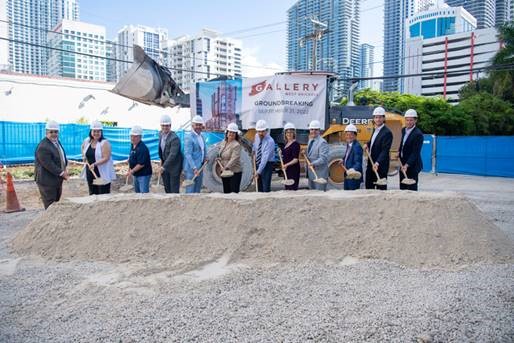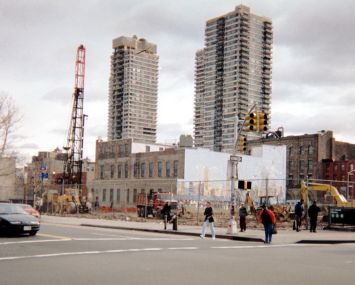Presented By: Future of Series presented by JPMorgan Chase
The Gallery at West Brickell to Provide Affordable Housing to Miami’s Workforce
Future Of Affordable Housing brought to you by JPMorgan Chase
By Future of Series presented by JPMorgan Chase October 17, 2022 1:30 pm
reprints
JPMorgan Chase is no stranger to financing much-needed affordable housing in low- to middle-income communities. The firm has deployed $5 billion around the country to assist in the creation of such housing in 2021.
This makes the recent announcement of the firm’s largest Community Development deal in Florida — The Gallery at West Brickell — especially exciting. The deal will ensure local families, teachers and other workforce residents can live in the urban core.

With the exception of New York, The Gallery at West Brickell is the largest deal within JPMorgan Chase’s Central and East regions. It’s also the largest single issuance of tax-exempt multifamily revenue by the Housing Finance Authority of Miami-Dade County.
“The Gallery at West Brickell was designed from the ground up to be on par with its market-rate counterparts. Featuring a mix of conveniences and luxuries, the offerings raise the bar for future workforce housing,” said Tammy Haylock-Moore, executive director, community development banking, JPMorgan Chase. “A lot of the employment in South Florida — especially new employment — is coming from the travel, tourism and resort sectors. Workers often cannot afford to live close to their places of employment, which raises their commuting costs. Through this groundbreaking development, we, along with our partners, are paving the way for hundreds of local families to find accessibly priced homes in a Class A development located within a block of mass transit.”
The Gallery at West Brickell will be a diversified, mixed-income, mixed-use residential rental development that will serve market-rate, low-income and workforce households that have been priced out of Miami. Given the dearth of affordable housing in the area, this deal promises to be transformative, providing homes for many who might otherwise have had to relocate due to high housing costs in Miami’s Central Business District and surrounding communities.
This Class A multifamily development will include 465 rental units, an adjacent garage and first-floor community-oriented retail, plus a slew of amenities, including a rooftop swimming pool, a dog park, offices and conference rooms, a fitness center and in-unit washers and dryers. The complex is next to the Southside Preparatory and Schoolhouse Apartments development, so there will also be housing for education professionals right next door.
Ninety-three of the units — 20 percent of the complex — are designated for households at or below 50 percent of the area median income (AMI) who will obtain HUD rental assistance, and 70 units (15 percent) are reserved for households at or below 140 percent AMI. The remaining 302 units will be unrestricted.
The deal seemed tailor-made for JPMorgan Chase’s Community Development Banking team, which provided a $145 million facility that funded a construction loan to finance the development. This facility is proposed to be repaid with 4 percent Low Income Housing Tax Credit (LIHTC) equity, along with permanent debt from Freddie Mac. Community support was also provided via subsidized soft debt from the City of Miami, Miami-Dade County and Miami School Board. This support will assist in the development of a 3,000-square-foot space in the lobby that will host an art gallery with revolving exhibits of local underprivileged young artists, as well as space for events and social gatherings.
While JPMorgan Chase prides itself on its experience in these matters, a deal this complex is never without its challenges.
“The greatest challenges that resulted in significant delays were primarily attributed to the rising cost of construction, coupled with rising interest rates,” said Haylock-Moore. “Also, work on Class A multifamily developments often requires government assistance, which can be hard to come by.”
Government-provided housing subsidies are often funded with tax receipts. But the past few years have seen government coffers shrink, as business closures and other negative economic impacts have left them with less money to invest in affordable housing, making JPMorgan Chase’s contributions and expertise all the more crucial.
“The current environment presents challenges in the form of rising interest and inflation, so we’re working closely with our clients to provide innovative capital solutions,” said Haylock-Moore. “LIHTC and multifamily revenue tax-exempt bond allocations from the state and/or local housing authorities, coupled with available subsidies, are primary resources used to create new affordable housing units across the country, and our firm continues to do more with it. We also provide low-cost capital for community development financial institutions (CDFIs) that serve small businesses, minority developers and affordable housing. Additionally, we make New Markets Tax Credit (NMTC) investments to support the development of commercial facilities for small businesses that contribute to healthy, thriving neighborhoods, such as grocery stores, day care centers, schools and health clinics.”
The firm is also funding local initiatives to provide workforce training to help Miami residents take advantage of the region’s growing economic opportunities.
The Gallery at West Brickell deal is the newest chapter in JPMorgan Chase’s long history with South Florida. The firm has more than 2,400 local employees in the region, including at 190 local bank branches.
In 2020, JPMorgan Chase announced a five-year, $30 billion Racial Equity Commitment that sees the company financing the creation and preservation of 100,000 affordable rental units through $14 billion in new loans, equity investment and other efforts. As such, the firm’s investments in South Florida and nationwide can help solve the country’s severe shortage of affordable housing.
“Affordable homes support the local workforce so they can live close to their jobs, and shorter commutes allow workers to spend more time with their families,” said Haylock-Moore. “Housing for the cohort that makes 80 percent to 140 percent AMI — too much to qualify for LIHTC, but not enough to live in Class A multifamily rental housing or market-rate units — tends to be overlooked. JPMorgan Chase, however, is working to change that.”
View more articles on affordable housing here.


